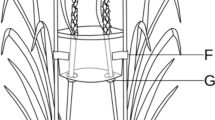Abstract
We evaluated the attraction of male almond seed wasp Eurytoma amygdali to the synthetic alkadienes (Z,Z)-6,9-tricosadiene and (Z,Z)-6,9-pentacosadiene and their blend in almond orchards using baited rubber septa attached to cardboard rectangular adhesive traps. The two alkadienes were recently isolated from virgin female whole body extracts and SPME collected volatiles. The alkenes (Z)-9-tricosene, (Z)-9-pentacosene, and (Z)-9-heptacosene, present in female extracts, were also added to the blend of the alkadienes and tested. The alkadienes tested individually attracted males when the traps were baited with doses ranging from 10 to 30 mg/trap. The maximum number of males was attracted to traps baited with 10 mg of a (Z,Z)-6,9-C23:2:(Z,Z)-6,9-C25:2 blend at a ratio of 7:3. Results with the three alkenes added to the blend were inconclusive because of low populations. The present study on E. amygdali is the first one reporting attraction of males to synthetic sex pheromone components in field trials for a Eurytomidae species. The synthetic alkadienes blend offers the potential to develop an effective system for monitoring populations of the almond seed wasp in almond orchards.
Similar content being viewed by others
REFERENCES
Antony, C., Davis, T. L., Carson, D. A., Pechine, J. M., and Jallon, J. M. 1985. Compared behavioral responses of male Drosophila melanogaster (Carton S) to natural and synthetic aphrodisiac. J. Chem. Ecol. 11:1617–1629.
Antony, C. and Jallon, J. M. 1982. The chemical basis for sex recognition in Drosophila melanogaster. J. Insect Physiol. 11:873–880.
Arambourg, Y., Fauvel, F., and Chevin, H. 1983. Eurytoma amygdali End et sa présence en France. Un nouveau chalcidien ravageur de l'amandier. Arboric Frutière. 358:27–28.
Avidov, Z. and Harpaz, I. 1969. Plant Pests in Israel. Israel University Press, Jerusalem, 599 pp.
CardÉ, R. and Baker, T. C. 1984. Sexual communication with pheromones, pp. 355–383, in W. J. Bell and R. T. Cardé (eds). Chemical Ecology of Insects. Chapman and Hall, London.
Carlson, D. A., Mayer, M. S., Silhacek, D. L., James, H. D., Beroza, M., and Bierl, B. A. 1971. Sex attractant pheromone of house fly—isolation, identification and synthesis. Science 174: 76–78.
DÉscoins, C., Lalanne-Cassou, B., FrÉrot, B., Malosse, C., and Renou, M. 1989. Comparative study of pheromonal secretions produced by arctiid and ctenuchid female moths (Insecta, Lepidoptera) from the neotropical area. C.R. Acad. Sci. Paris, t.309 Sér. III:577–581.
Grant, G. C., Fokal, W. H., West, R. J., Slessor, K. N., and Miller, G. E. 1989. A sex attractant for the spruce seed moth, Cydia strobilella (L.) and the effect of lure dosage and trap height on capture of male moths. Can. Entomol. 121:691–697.
Ivanov, S. 1960. Eurytoma amygdali End. in Bulgaria and its control. Rastit. Zasht. 8:41–46.
Kamm, J. A. and Buttery, R. G. 1986. Response of the alfalfa and clover seed chalcids (Hymenoptera: Eurytomidae) to host plant components. Environ. Entomol. 15:1244–1249.
Katsoyannos, B. I., Kouloussis, N. A., and Bassiliou, A. 1992. Monitoring populations of the almond seed wasp, Eurytoma amygdali, with sex pheromone traps and other means, and optimal timing of chemical control. Entomol. Exp. Appl. 62:9–16.
Knutson, A. E., Harris, M. K., and Millar, J. G. 1998. Effects of pheromone dose, lure age, and trap design on capture of male pecan nut casebearer (Lepidoptera: Pyralidae) in pheromone-baited traps. J. Econ. Entomol. 91:715–722.
Krokos, F. D., Konstantopoulou, M. A., and Mazomenos, B. E. 2001. Alkadienes and alkenes mediating mating behavior of the almond seed wasp Eurytoma amygdali. J. Chem. Ecol. 27:2169–2181.
Leal, W. S., Lacerda-Moura, J. I., Bento, J. M. S., Vilela, E. F., and Pereira, P. B. 1997. Electrophysiological and behavioral evidence for a sex pheromone in the wasp Bephratelloides pomorum. J. Chem. Ecol. 23:1281–1289.
Light, D. M., Kamm, J. A., and Buttery, R. G. 1992. Electroantennogram response of alfalfa seed chalcid, Bruchophagus roddi (Hymenoptera: Eurytomidae) to host-and nonhost-plant volatiles. J. Chem. Ecol. 18:333–352.
Mentzelos, J. and Atjemis, A. 1970. Studies on the biology and control of Eurytoma amygdali in Greece. J. Econ. Entomol. 63:1934–1936.
Nadel, H. and PeŇa, J. E. 1991. Seasonal oviposition and emergence activity of Bephratelloides cubensis (Hymenoptera: Eurytomidae), a pest of Annona species in Florida. Environ. Entomol. 29:1053–1057.
Nemoto, T., Doi, M., Oshio, K., Matsubayashi, H., Oguma, Y., and Kuwahara, Y. 1994. (Z,Z)-5,27-Tritriacontane: Major sex pheromone of Drosophila pallidosa (Diptera: Drosophilidae). J. Chem. Ecol. 20:3029–3037.
Oguma, Y., Nemoto, T., and Kuwahara, Y. 1992. (Z)-11-Pentacosene is the major sex pheromone component in Drosophila virilis (Diptera). Chemoecology 3:60–64.
Plaut, H. N. 1971. On the biology of the adult of the almond seed wasp, Eurytoma amygdali End. (Hym., Eyrytomidae) in Israel. Bull. Entomol. Res. 61:275–281.
Plaut, H. N. 1972. On the biology of the immature stages of the almond seed wasp, Eurytoma amygdali End. (Hym., Eurytomidae) in Israel. Bull. Entomol. Res. 61:681–687.
Roelofs, W. L. and CardÉ, R. T. 1974. Oriental fruit moth and lesser appleworm attractant mixtures redefined. Environ. Entomol. 3:587–598.
SAS Institute 1995. SAS User's Guide: Statistics. SAS Institute, Gary, NC.
Snedecor, G. W. and Cochran, W. G. 1989. Statistical Methods, 8th edn. Iowa State University Press, Ames.
Sokal, R. R. and Rohlf, F. J. 1995. Biometry, 3rd edn. Freedman & Company, New York.
Talhouk, A. S. 1977. Contributions to the knowledge of almond pests in East Mediterranean countries. V. The fruit-feeding insects, Eurytoma amygdali End., and Anarsia lineatella. Z. Angew. Entomol. 83:145–154.
Tzanakakis, M. E., Karakassis, E. J., Tsaklidis, G., Karabina, E. C., Argalavini, I. C., and Arabatzis, I. G. 1991. Diapause termination in the almond seed wasp, Eurytoma amygdali Endrlein (Hym., Eurytomidae), in northern Greece and under certain photoperiods and temperatures. J. Appl. Entomol. 111:86–98.
Zerova, M. D. and Fursov, V. N. 1991. The palearctic species of Eurytoma (Hymenoptera: Eurytomidae) developing in stone fruits (Rosaceae: Prunoideae). Bull. Entomol. Res. 81:209–219.
Author information
Authors and Affiliations
Rights and permissions
About this article
Cite this article
Mazomenos, B.E., Athanassiou, C.G., Kavallieratos, N. et al. Evaluation of the Major Female Eurytoma amygdali Sex Pheromone Components, (Z,Z)-6,9-Tricosadiene and (Z,Z)-6,9-Pentacosadiene for Male Attraction in Field Tests. J Chem Ecol 30, 1245–1255 (2004). https://doi.org/10.1023/B:JOEC.0000030275.17006.f3
Issue Date:
DOI: https://doi.org/10.1023/B:JOEC.0000030275.17006.f3




